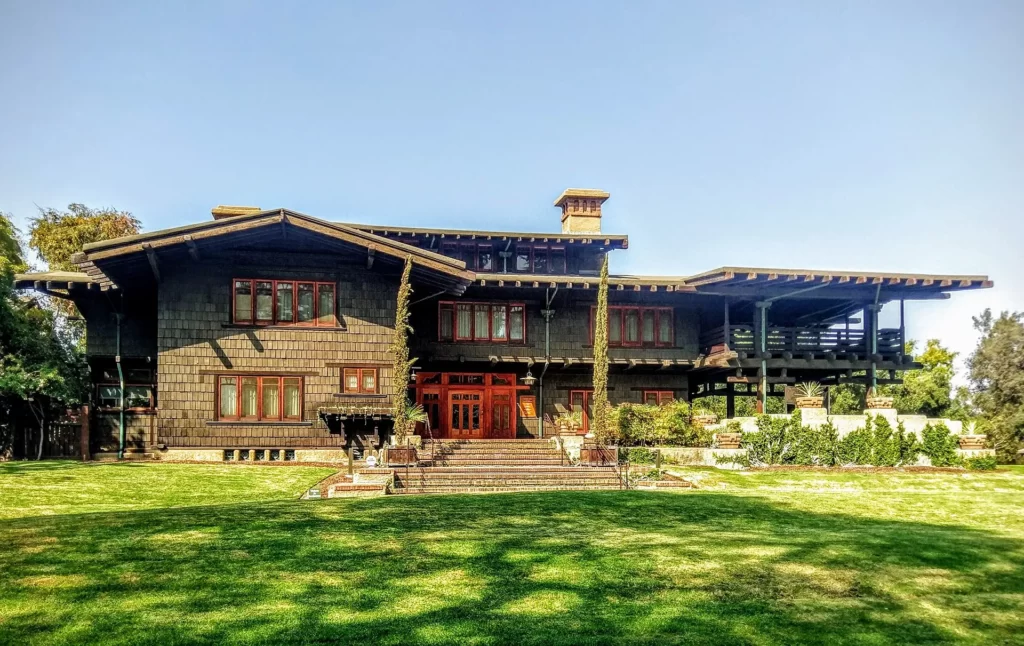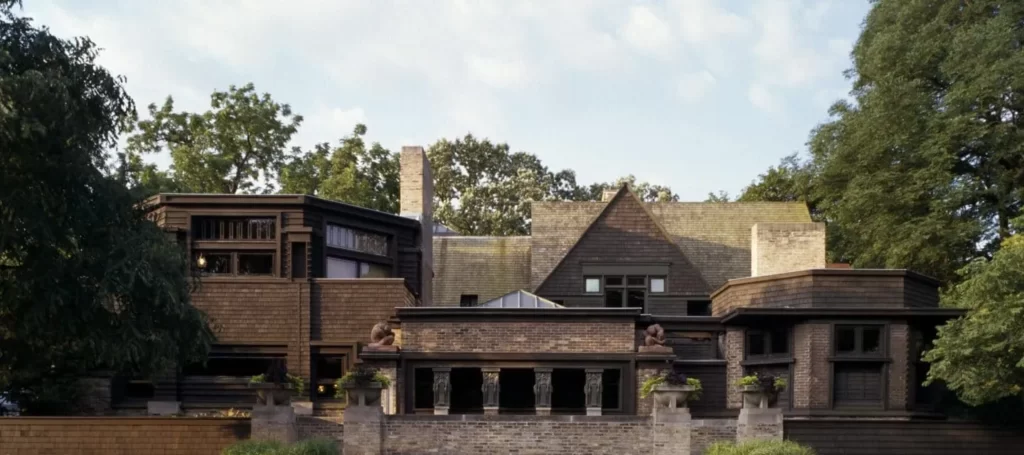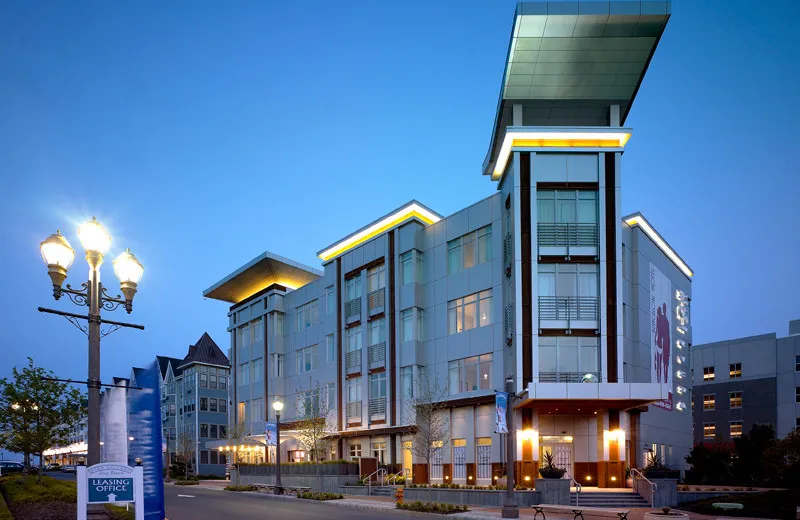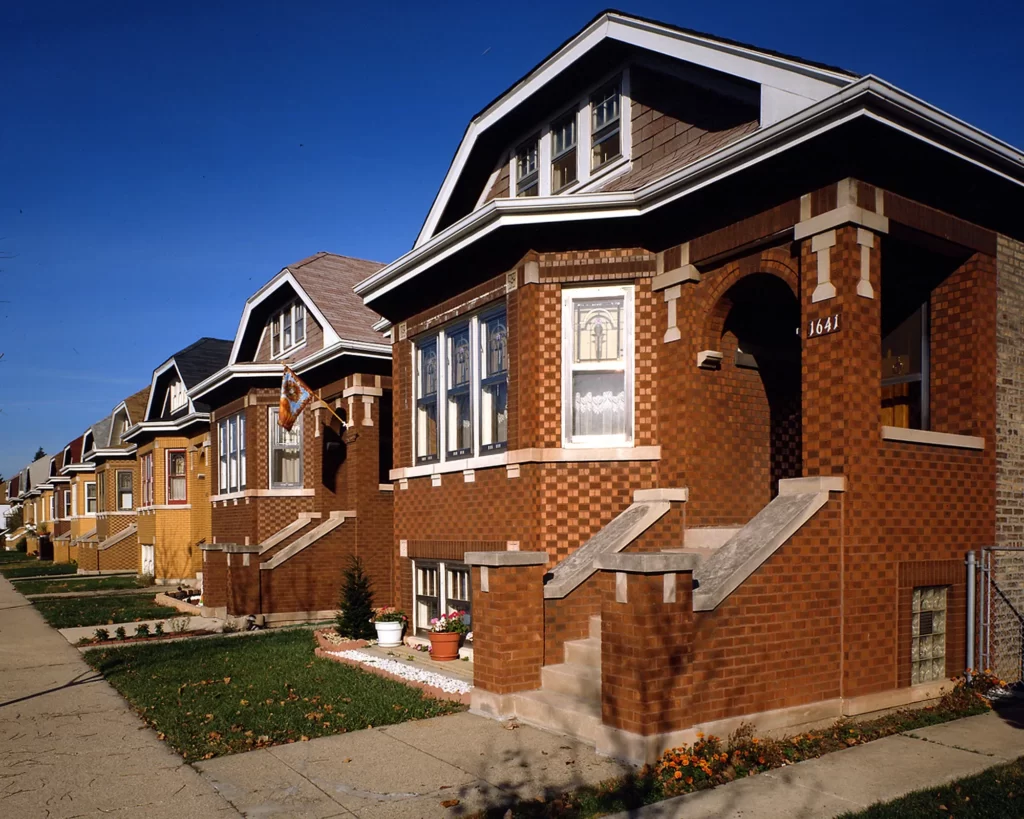If you want to know about the staircase design or landscape garden or requirements for disabled persons in a building, please click the link.
Introduction
A bungalow building is a single-story house, often with a low-pitched roof and a wide front porch. Bungalows typically feature an open floor plan and use natural materials such as wood, stone, and brick. Bungalow homes are known for their simplicity and functionality, and are often associated with the Arts and Crafts movement.

Brief history of bungalow architecture
The bungalow style originated in India, where it was used to describe small, thatched-roof houses. The design was brought to Britain by the East India Company in the late 18th century, and became popular in the United States in the early 20th century.
Bungalow architecture was heavily influenced by the Arts and Crafts movement, which emphasized the use of natural materials and the importance of craftsmanship. Bungalows were seen as a response to the excesses of Victorian architecture, and were designed to be simple, functional, and affordable.
Importance of bungalow design in modern architecture
Bungalow design continues to be an important influence in modern architecture, particularly in the areas of sustainability and efficiency. The simple, functional layout of bungalow homes is well-suited to modern lifestyles, and their emphasis on natural materials and energy efficiency has made them popular with environmentally-conscious homeowners.
Bungalow design also continues to influence the development of new housing communities, with many developers incorporating bungalow-inspired design elements into their projects. Overall, bungalow architecture represents a timeless and enduring style that continues to inspire and influence modern design.
1) Types of Bungalow Building Design
Bungalows are typically single-story houses or cottages that are often characterized by their low-pitched roofs, open floor plans, and wide front porches. There are several types of bungalow building designs, including:
- Classic bungalow design: Classic bungalow design refers to the original style of bungalow homes, which emerged in the early 20th century. These homes feature traditional design elements such as low-pitched roofs, wide front porches, and Craftsman-style details.
- Modern bungalow design: Modern bungalow design takes inspiration from the classic style but incorporates contemporary design elements, such as clean lines, minimalist finishes, and energy-efficient features.
- Coastal bungalow design: Coastal bungalow design emphasizes a light and airy aesthetic, with a focus on natural materials and a color palette that reflects the beach and ocean. These homes often feature large windows and outdoor living spaces that take advantage of coastal views.
- Rustic bungalow design: Rustic bungalow design takes inspiration from nature, with a focus on natural materials and textures such as wood, stone, and exposed brick. These homes often feature a cozy, cabin-like feel with a warm, inviting atmosphere.
- Bungalow-inspired interior design: Bungalow-inspired interior design takes cues from the architectural style and emphasizes a warm, inviting aesthetic with a focus on natural materials, cozy furnishings, and handcrafted details. These interiors often feature open floor plans, ample natural light, and a seamless flow between indoor and outdoor spaces.
- Craftsman Bungalow: This style of bungalow originated in the early 20th century and is known for its handcrafted details, such as exposed rafters, built-in cabinetry, and decorative brackets.
- California Bungalow: Developed in the early 1900s, the California bungalow features a low-pitched roof, wide eaves, and an open floor plan that emphasizes natural light and outdoor living.
- Prairie Style Bungalow: This design was popularized by Frank Lloyd Wright and emphasizes horizontal lines, flat or low-pitched roofs, and integration with the surrounding landscape.
- Ranch Style Bungalow: This style is a combination of the bungalow and ranch designs and features a low-pitched roof, open floor plan, and an emphasis on indoor-outdoor living.
- Cottage Style Bungalow: These homes are characterized by their cozy, welcoming feel, and often feature a steeply pitched roof, asymmetrical façade, and quaint details like dormer windows and flower boxes.
These are just a few examples of the different types of bungalow building design that have emerged over time. Each style has its own unique characteristics and features, but all share a focus on craftsmanship, natural materials, and an emphasis on indoor-outdoor living.
2) Key Elements of Bungalow Building Design
Bungalow building design is characterized by several key elements that contribute to its distinctive style, including:
- Low-pitched roofs: Bungalows typically feature low-pitched roofs with wide overhangs, which help to protect the home from the elements while also providing shade and ventilation.
- Open floor plans: Bungalows often have open floor plans, with a seamless flow between living spaces. This design promotes a sense of togetherness and allows for easy circulation throughout the home.
- Wide front porches: Bungalows are often characterized by their wide, inviting front porches, which serve as an extension of the living space and encourage outdoor living and socializing.
- Natural materials: Bungalows are typically constructed from natural materials such as wood, stone, and brick, which give them a warm, inviting feel and help them blend in with their surroundings.
- Craftsman-style details: Bungalows often feature intricate details and craftsmanship, such as handcrafted woodwork, stained glass windows, and decorative brackets, which add to their charm and character.
- Built-in cabinetry: Craftsman bungalows often feature built-in cabinetry, such as bookcases, cabinets, or benches, that are integrated into the design of the house.
- Exposed rafters and beams: Bungalows often feature exposed rafters and beams, which add to the overall aesthetic of the house and provide structural support.
- Simple ornamentation: Bungalow design typically features simple, understated ornamentation, such as decorative brackets or corbels, that add visual interest without overwhelming the overall design.
- Emphasis on indoor-outdoor living: Many bungalow designs incorporate features that blur the line between indoor and outdoor living, such as large windows that bring in natural light and a connection to the surrounding landscape, or doors that open onto a covered porch or patio.
These key elements are integral to the bungalow building design and contribute to the style’s overall aesthetic and functionality.
3) Advantages of Bungalow Building Design
There are several advantages to building a home in the bungalow style, including:
Energy efficiency and sustainability of bungalow building design
Bungalow building design can be energy-efficient and sustainable due to its focus on natural materials, passive solar design, and efficient use of space. Bungalows often have large windows that let in natural light and heat, which reduces the need for artificial lighting and heating.
Bungalows also often have deep eaves that provide shade in the summer and protection from wind and rain in the winter. In addition, bungalows can be built with sustainable materials like reclaimed wood or recycled materials, which reduces their environmental impact.
Comfort and livability of bungalow building design
Bungalow building design is often associated with comfort and livability due to its open floor plans, large porches, and emphasis on natural light and ventilation. Bungalows are typically designed with the needs of the occupants in mind, and may include features like built-in bookshelves, window seats, and fireplaces.
Bungalows are also often designed to be accessible and easy to maintain, which makes them ideal for aging in place or for people with disabilities.
Cost-effectiveness of bungalow building design
Bungalow building design can be cost-effective due to its simple, straightforward construction and focus on natural materials. Bungalows are often designed to be built with locally-sourced materials, which reduces transportation costs and supports local economies.
In addition, bungalows can be designed to be energy-efficient and low-maintenance, which reduces long-term operating costs. Finally, bungalows are often designed with an eye toward flexibility and adaptability, which allows them to be easily modified or expanded over time as the needs of the occupants change.
Overall, bungalow building design offers a number of advantages in terms of energy efficiency, comfort, livability, and cost-effectiveness, which makes it a popular choice for many different types of buildings.
- Accessibility: Bungalows are typically designed as single-story homes, which makes them ideal for people with mobility issues or those who want to age in place.
- Open floor plan: Bungalow designs often emphasize an open floor plan, which makes the home feel larger and more spacious.
- Indoor-outdoor living: Bungalows often feature a wide front porch and other outdoor living spaces, which encourages a connection to the outdoors and allows for easy entertaining.
- Natural light: Bungalows often have large windows that bring in natural light, creating a bright and inviting atmosphere.
- Energy efficiency: With a single story and compact design, bungalows can be more energy efficient than multi-story homes, as they require less heating and cooling.
- Low maintenance: Bungalows are typically designed with simple, understated ornamentation and natural materials, which require less maintenance and upkeep than more ornate styles.
- Timeless design: Bungalow design has been popular for over a century, and its simple, functional style has stood the test of time.
- Customization: Bungalow designs can be easily customized to suit individual preferences and needs, with a wide range of styles and features to choose from.
- Flexibility in design: Bungalow homes are known for their open floor plans and flexible design, which allows for easy customization and adaptation to different needs and lifestyles. The seamless flow between indoor and outdoor spaces also adds to the flexibility of the design.
- Connection to nature: Bungalow homes are designed to blend in with their natural surroundings, with features such as wide front porches, natural materials, and landscaping that enhance the connection to nature. This creates a sense of peace and relaxation, and promotes a healthy lifestyle.
- Cozy and comfortable living spaces: Bungalow homes are known for their cozy and comfortable living spaces, with features such as built-in storage, window seats, and fireplaces that add warmth and character to the home.
4) Tips for designing a bungalow home
If you’re interested in designing a bungalow home, here are some tips to keep in mind:
- Consider the site and location: When designing a bungalow home, it’s important to choose a site that is well-suited for the style. Look for a flat or gently sloping lot with mature trees and a sense of privacy. Consider factors such as sun exposure, prevailing winds, and views.
- Embrace natural surroundings: Bungalow homes are designed to blend in with their natural surroundings, so it’s important to choose materials and finishes that complement the landscape. Use natural materials such as wood, stone, and brick, and incorporate landscaping and outdoor living spaces that take advantage of the views and natural features of the site.
- Focus on function and flow: Bungalow homes are known for their open floor plans and seamless flow between indoor and outdoor spaces. When designing a bungalow home, think carefully about how each room will be used and how people will move through the space. Consider adding features such as built-in storage, window seats, and cozy nooks to enhance the functionality of the home.
- Incorporate craftsman-style details: Bungalow homes are known for their intricate craftsmanship and attention to detail. When designing a bungalow home, consider adding elements such as handcrafted woodwork, stained glass windows, and decorative brackets to add character and charm.
- Prioritize sustainability: Bungalow homes were originally designed with energy efficiency and sustainability in mind. When designing a bungalow home, consider incorporating features such as passive solar design, high-efficiency HVAC systems, and sustainable building materials to reduce the home’s environmental impact and lower energy costs.
- Emphasize natural materials: Bungalow homes are often built with natural materials such as wood, stone, and brick, so try to incorporate these elements into the design wherever possible.
- Pay attention to proportions: Bungalow homes typically have low-pitched roofs, wide eaves, and a horizontal emphasis, so pay attention to these proportions when designing the house.
- Focus on the front porch: The front porch is an important feature of the bungalow style, so make sure it’s large enough to accommodate outdoor furniture and encourages a connection with the surrounding landscape.
- Keep it simple: Bungalow homes are known for their simple, understated ornamentation, so avoid overcomplicating the design with too many details or flourishes.
- Incorporate built-in cabinetry: Bungalow homes often feature built-in cabinetry, such as bookcases or benches, which can be integrated into the design to maximize storage and add to the overall aesthetic.
- Opt for an open floor plan: Bungalow homes often emphasize an open floor plan, with a central living area that minimizes the use of hallways and encourages a connection between rooms.
- Incorporate natural light: Bungalow homes often have large windows that bring in natural light, so make sure to include ample windows to create a bright and inviting atmosphere.
- Consider the surroundings: Bungalow homes are often designed to blend in with their surroundings, so consider the landscape and surrounding architecture when designing the house to create a cohesive look.
These tips can help you create a bungalow home that is both functional and beautiful, with a focus on craftsmanship, natural materials, and sustainable design.
5) Examples of Notable Bungalow Building Designs
There are many notable bungalow building designs around the world, some of which are:
Gamble House in Pasadena, California:

The Gamble House is a notable example of bungalow building design, designed by architects Charles and Henry Greene in the Arts and Crafts style. Completed in 1909, the house features a range of traditional bungalow design elements, including exposed beams, handcrafted woodwork, and built-in cabinetry. The Gamble House has been designated a National Historic Landmark and is open to the public for tours.
Frank Lloyd Wright’s Bungalow Home in Oak Park, Illinois:

Frank Lloyd Wright’s Home and Studio in Oak Park is a prime example of bungalow building design, with a focus on natural materials, craftsmanship, and indoor-outdoor living. Completed in 1889, the house features a low-pitched roof, overhanging eaves, and a covered porch, as well as an open floor plan and large windows that blur the boundaries between indoors and outdoors.
The Bungalow Hotel in Long Branch, New Jersey

The Bungalow Hotel is a modern take on the bungalow style, with a focus on minimalism, sustainability, and innovation. The hotel features a sleek, modern design with clean lines, monochromatic finishes, and high-tech features like smart home systems and energy-efficient appliances. The Bungalow Hotel has been recognized for its eco-friendly design and has received several awards for sustainability.
The Arts and Crafts bungalows in Arroyo Seco, California:

The Arroyo Seco neighborhood in Pasadena is known for its collection of Arts and Crafts bungalows, which were built in the early 20th century. These bungalows feature a range of traditional design elements, including handcrafted woodwork, stained glass windows, and decorative brackets. Many of the bungalows in Arroyo Seco have been restored and preserved, and the neighborhood is a popular destination for architecture enthusiasts.
The “Bungalow Belt” neighborhood in Chicago, Illinois:

The “Bungalow Belt” is a historic neighborhood in Chicago that is known for its collection of bungalow-style homes. These homes were built in the early 20th century and feature a range of traditional design elements, including low-pitched roofs, overhanging eaves, and handcrafted details. The Bungalow Belt is recognized as a significant example of bungalow building design and has been designated a Chicago Landmark district.
These are just a few examples of notable bungalow building designs, which showcase the diversity and variety of this architectural style.
6) Trends in Bungalow Building Design
Bungalow building design has seen a resurgence in popularity in recent years, with many homeowners and architects embracing its simple, functional style. Here are some current trends in bungalow building design:
Modern bungalow building design trends:
Modern bungalow building design trends include a focus on minimalism, sustainability, and innovation. Modern bungalows often have a more streamlined, geometric design, with clean lines and a monochromatic color palette. They may also incorporate high-tech features like solar panels, smart home systems, and energy-efficient appliances.
In addition, modern bungalows often emphasize indoor-outdoor living, with large sliding glass doors that open up to outdoor spaces like patios or gardens.
Traditional bungalow building design trends:
Traditional bungalow building design trends emphasize simplicity, craftsmanship, and natural materials. Traditional bungalows often have a more rustic, handcrafted look, with exposed beams, natural wood finishes, and handcrafted tiles or mosaics.
They may also incorporate traditional architectural elements like decorative brackets, corbels, or gable ends. In addition, traditional bungalows often emphasize a connection to nature, with large windows, covered porches, and outdoor spaces that blend seamlessly with the surrounding landscape.
Cultural influences on bungalow building design trends:
Bungalow building design has been influenced by many different cultures and regions, which has led to a wide variety of styles and variations. For example, in California, the bungalow style is often associated with the Arts and Crafts movement, and features handcrafted details like tile work, stained glass, and custom woodworking.
In the Philippines, the bungalow style is known as the bahay kubo, and is characterized by its use of bamboo and thatch. In India, the bungalow style is often associated with colonial architecture, and features a mix of European and Indian design elements. Cultural influences can also be seen in the colors, patterns, and textures used in bungalow building design, which can reflect the local climate, landscape, and traditions.
Overall, bungalow building design trends are diverse and varied, reflecting the many different influences and contexts that have shaped this architectural style over time.
7) Conclusion
Bungalow building design has a rich history and continues to be a popular architectural style today. Its emphasis on craftsmanship, natural materials, and indoor-outdoor living has made it a timeless choice for homeowners who value both beauty and functionality.
Bungalow homes are also known for their energy efficiency and sustainability, which is becoming increasingly important as we work to reduce our environmental impact. By embracing bungalow building design in our homes, we can create spaces that are both beautiful and sustainable.
Call to Action
Whether you’re designing a new home or renovating an existing one, bungalow building design is a great choice. By incorporating elements such as low-pitched roofs, wide front porches, and natural materials, you can create a home that is both functional and beautiful.
And by prioritizing sustainability and energy efficiency, you can reduce your environmental impact and lower your energy costs. So if you’re looking for a timeless architectural style that combines beauty and function, consider bungalow building design.